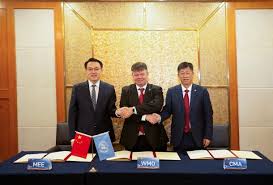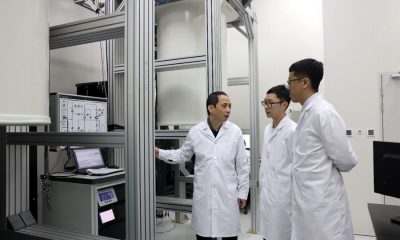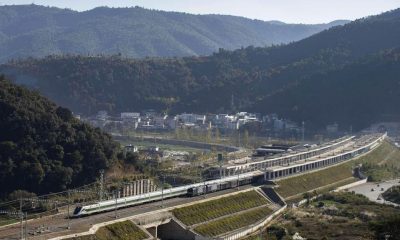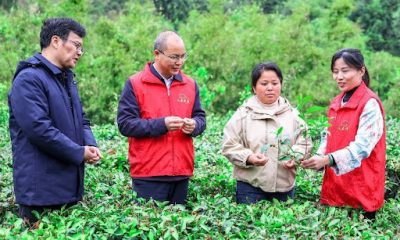Foreign
China’s Spring Festival box office off to strong start

By Liu Yang, People’s Daily
China’s film industry set a new milestone during the 2025 Spring Festival holiday.
According to the China Film Administration, the country’sbox office revenue during this period reached a staggering 9.51 billion yuan ($1.3 billion), with 187 million moviegoers packing theaters, up 18.64 percent and 14.68 percent from a year ago, respectively.
As of 9:00 a.m. on Feb. 5, the total box office revenue since the beginning of 2025 had amounted to 11.63 billion yuan, with240 million moviegoers attending theaters.
Six Chinese films hit the big screen in the Spring Festival holiday this year, including “Ne Zha 2,””Boonie Bears: Future Reborn,””Detective Chinatown 1900,””Operation Hadal,””Creation of the Gods II: Demon Force,” and “Legends of the Condor Heroes: The Gallants.”
“The effective and sufficient supply of high-quality films is key to the historic high box office,” said Rao Shuguang, president of the China Film Critics Association.
Rao said that the six films cover a wide range of genres, such as action, animation, wuxia (literally meaning “martial arts heroes”), comedy, suspense, and Chinese mythology. “All of them boast distinctive Chinese style and temperament, and can satisfy the diverse needs of the Chinese audience,” noted Rao.
“Besides eating dumplings, setting off firecrackers, and watching the Spring Festival gala, Chinese people can also immerse themselves in movies – a delightful experience featuring more cultural elements,” said Yin Hong, a professorat Tsinghua University.
In recent years, China’s film industry has seen rapid development, marked by accelerated cinema construction and a more complete cinema network in third- and fourth-tier cities. The number of cinema screens in China has exceeded 90,000. The improved cinema infrastructure has provided solid support for rising box office revenues.
At the same time, more high-definition (HD) films are emerging in the Chinese film market, as IMAX, CGS, CINITY, Dolby Cinema, and other theaters have enhanced their movie-watching experience by introducing advanced special effects. Many theaters in China have also improved their equipment and services, providing audiences with a technology-enabled cinematic experience.
Among the holiday film lineup, “Ne Zha 2″has emerged as the undisputed leader. As of Feb. 6, the animated blockbuster’s earnings had exceeded 5.77 billion yuan, making it the highest-grossing film of all time in China. This milestone comes on the heels of the series’ first installation, “Ne Zha,”which grossed over 5 billion yuan and topped the country’s box office charts in 2019.
Before its premiere, “Ne Zha”went through 66 script revisions and featured over 1,400 special effects shots. The number of characters in “Ne Zha 2” is three times that of its predecessor, with nearly 2,000 special effects shots offering an even more immersive cinematic experience.
“When making animations, we prefer quality over quantity. We won’t settle for anything that doesn’tmeet our standards. We believe our audience will appreciate the films that were made with genuine sincerity,” said the film’s director Yang Yu, also known as Jiaozi.
Patriotism, traditional Chinese culture, IP movies, and film industrialization are the key themes of this year’s Spring Festival movie season. The fantasy epic “Creation of the Gods” incorporates numerous elements of Chinese intangible cultural heritage, with many architectural designs inspired by China’s”chuandou” structure, a distinctive type of traditional Chinese architecture that allows for much more flexibility in roof and wall design.
“Chinese intangible cultural heritage has been passed down for centuries. We should better understand and incorporate these cultural elements into our film creation. As Chinese filmmakers, we are incredibly fortunate to have this cultural wealth at our disposal,”said Wu Ershan, director of the series.
“All six films in this year’s Spring Festival holiday are productions frompopular IPs. The key to a successful film series lies in the creator’s ability to make constant innovation. Only through perpetual learning and adaptation can filmmakers grow alongside their audience,” said Chen Sicheng, director of “Detective Chinatown 1900.”
This year marks the 10th anniversary of the “Detective Chinatown”movie series. Since debuting in 2015, the series has released four films and two spin-offs, Chen said.
Film industrialization contains three key aspects: specific genres, standardized production management, and the application of new technologies. The six films in this year’s Spring Festival holiday embody all the three characteristics.
The success of these films has significantly boosted tourism, as the filming locations and story settings have turned into popular travel destinations. Many regions in China have seized the opportunity to enhance their tourism offerings, providing a wider range of options for audiences to explore filming sites, taste local delicacies, and immerse themselves in cinematic experiences – all contributing to a more vibrant cultural tourism market.
For example, “Detective Chinatown 1900” was filmed in the Laoling Film Studio in Dezhou, east China’s Shandong province. The set, which covers nearly 200,000 square meters, was constructed in seven months. Taking advantage of the film’s popularity, the studio opened a themed park during the Spring Festival holiday this year, attracting tens of thousands of visitors on the first day alone.
“It feels like stepping straight into the movie. I was completely immersed in the story,” one visitor remarked.
“Films have never been just about box office revenue; they also generate significant spillover effects. In recent years, various industries have shown a greater willingness to collaborate with filmmakers, which amplifies their impact and invigorates new consumption models and immersive entertainment experiences,” said Yin.
Foreign
China’s new chapter in global innovation

By Gu Yekai, Liu Yiqing, People’s Daily
At a smart construction project site managed by China State Construction Engineering Corporation, a quiet technological revolution is underway. Amid cranes and concrete, engineers are deploying advanced artificial intelligence (AI) systems that could fundamentally reshape the construction industry.
Li Fengjian, an AI specialistwith Xianyuan Technology, detailed how the company’s latest intelligent system – built on a large model – adapts to complex construction environments.”Engineering machinery equipped with intelligent agents can adjust its operations automatically in response to weather conditions,” Li explained, adding that a spatiotemporal sensing network further enhances the system, providing real-time tracking of both personnel and materials throughout the construction site.
In February this year, Xianyuan Technology rapidly integrated its self-developed model with DeepSeek-R1, effectively blending a general-purpose framework with industry-specific models. This integration, Li noted, has produced a solution capable of delivering expert-level performance in challenging, dynamic environments. The firm is based in the Shanghai Foundation Model Innovation Center, aburgeoning AI incubator that now hosts over 200 innovative enterprises.
China’s technological transformation extends well beyond the construction sector. Overthe past three decades, the country has evolved from its initial forays into internet connectivity to becoming a key player in global digital innovation.
Here, a steady stream of technological innovations are emerging, from the early days of emails and web browsing to the cutting-edge technologies represented by DeepSeek and the dynamic evolution of social media.
Wu Jianping, an academician at the Chinese Academy of Engineering and headof the Zhongguancun Laboratory, pointed out that while China had introduced only one internet standard before 2005, it now contributes to over 200 worldwide. Such strides illustrate the country’s concerted push toward high-level technological self-reliance – a journey marked by both persistence and determination.
Beyond the digital realm, China is makingsignificant inroads in aerospace, new energy, and other high-tech sectors. It has transitioned from being a follower to standing shoulder-to-shoulder with global leaders, and in some areas, even taking the lead. Wu attributed these achievements to a dynamic ecosystem of policy reforms and talent cultivation that encourages creativity and technical expertise at every level.
Amid intensifying international competition, collaborative research and the integration of new technologies with traditional industries are central to China’s high-quality economic development.
Mei Linhai, a researcher at China’s State Key Laboratory of Cognitive Intelligence, remarked that the age of AI calls for continuous exploration. “In this era, everyone is an innovator. Only by persistently pushing the boundaries can we remain at the forefront of both technological and industrial development,” Mei observed.
In the field of general-purpose AI, Mei emphasized that independent innovation is paramount. He advocates for a self-driven industrial ecosystem that leveragesbreakthrough technologies to boost productivity and unlock new possibilities, Mei said.
Foreign
Chinese democracy in action:a village bench meeting shapes national law

By Wei Zhezhe, Liu Botong, People’s Daily
In a modest corner of Jiangmen, south China’s Guangdong province, residents of Weidong village are experiencing firsthand a form of democracy that starts at the grassroots level and reverberates all the way to Beijing.
Wu Tengxin, a local villager who relies on a scooter for daily mobility after contracting polio, recalls a time when the village’s public spaces were ill-equipped for people with disabilities. Now, thanks to a simple suggestion made during a meeting, his everyday life has changed.
In November 2022, a team from a local legislative outreach office – a branch of China’sNational People’s Congress (NPC) – visited Weidong village and set up a “bench-style meeting.” Residents, including the elderly and those with disabilities, gathered to voice their concerns about inadequate accessibility.
Amid the conversation, Wu offered a straightforward proposal: “I hope rural accessible facilities can be improved to make mobility easier for people with disabilities and the elderly.” His words were relayed verbatim to lawmakers.
The response was swift. On June 28, 2023, at the third session of the 14th NPC Standing Committee, legislators passed a law on building a barrier-free living environment. The law stipulates that improvements”shall align with social and economic development levels, coordinate urban and rural progress, and gradually narrow the gap in infrastructure between urban and rural areas.”
Today, Wu observes that the village’s main roads and public squares have been upgraded with accessibility features that make getting around considerably easier.
This episode illustrates what Chinese officials call “whole-process people’s democracy” – a system where citizen input is woven into every stage of policy development.
Jilie Ziri, head of Abuluoha village in Butuo county, southwest China’s Sichuan province, remarked that for young generations in China, democracy has become a lived experience. “Villagers are the masters of village affairs,” he said, emphasizing how active villager participation has injected new vitality into local governance.
Experts point to consultative democracy as a cornerstone of this process. Tao Kaiyuan, vice chairman of the Central Committee of the China Association for Promoting Democracy and vice president of the Supreme People’s Court, underscores the important role of the Chinese People’s Political Consultative Conference, whose members hail from every stratum of society and bring a wealth of expertise and connections.
Their regular forums, field research, and public consultations have created robust channels for citizens to contribute ideas and forge consensus.”This approach gathers collective wisdom and transforms public voices into policy,” Tao said.
Another crucial manifestation is the effectiveness of China’s political party system. Under the leadership of the Communist Party of China, Chinese democratic parties actively fulfill their duties, offering recommendations that often translate into concrete policy decisions. This integrated approach demonstrates the unique strengths of China’s political system and the advantages of whole-process people’s democracy.
Tao emphasized that whole-process people’s democracyhas evolved into an efficient and dynamic democratic practice – one that not only reflects the essence of socialist democracy but also presents a pioneering model of political civilization, contributing Chinese wisdom and solutions to global governance and democratic development.
Foreign
Chinese modernization: blueprint for global progress

By He Yin, People’s Daily
At China’s recent annual “two sessions,” Chinese modernization once again captured global attention. International observers are closely following a range of new measures designed not only to accelerate Chinese domestic transformation but also to unlock fresh opportunities for global development.
They believe that Chinese modernization, built on a foundation of openness and cooperation, will continue to yield global benefits with each new milestone.
Today, China stands as a formidable force in the global economy – accounting for around 18 percent of the global economy and nearly 30 percent of world manufacturing output. Year after year, the nation has contributed about 30 percent to global economic growth. With import and export records with almost all countries and regions designated in the United Nations Statistics Division, the country is a major trading partner for more than 150 countries and regions. In 2024, its exports to over 160 countries and regions saw growth.
Often hailed as the “world’s largest developing country,”the “second-largest economy,””world’s factory,””global market,” and “innovation powerhouse,” China is increasingly viewed as a beacon of stability and progress.
In recent years, high-profile events such as the seventh China International Import Expo – where intended deals exceeded $80 billion – and the establishment of over 1.239 million foreign-invested enterprises have reinforced the nation’s reputation as a vast, dynamic market.
Meanwhile, policies encouraging Chinese companies to “go global” have seen a steady stream of new technologies, goods, and services permeate international markets, knitting the country ever tighter into global value chains and bolstering its commitment to win-win cooperation.
The influence of Chinese modernization is evident far beyond its borders. In the Central African Republic, President Faustin-Archange Touadera has repeatedly screened China’s political documentary Carry the Reform Through to the End for cabinet discussions, while officialsin Uzbekistan are adapting China’s poverty-reduction experience to suit their national context. These moves challenge the assumption that modernization must follow Western models, suggesting that China’s alternative pathway offers a viable route to development.
Beyond economic growth, Chinese modernization is increasingly celebrated for its potential to foster win-win cooperation and shared prosperity.
Under the Belt and Road Initiative (BRI), for example, Kazakhstan secured its first maritime access and Laos launched its first modern railway. Support from the Global Development and South-South Cooperation Fund has propelled over 160 projects, benefiting more than 30 million people. Moreover, China has given all the least developed countries with which it has diplomatic relations zero-tariff treatment for 100 percent tariff lines, signaling its commitment to an open and inclusive global economy.
China’s modernization agenda also tackles global challenges head on. In response to global environmental risks, China advocates for building a community of all life on the Earth. To bridge the digital and AI divide, it has launched the AI Capacity-Building Action Plan for Good and for All to ensure that technological advancements benefit every corner of the globe.
On the security front, China continues to promote dialogue and reconciliation in conflict zones while engaging in multilateral security collaborations, reinforcing its reputation as a nation committed to peace and stability.
By proposing initiatives such as the Global Development Initiative, the Global Security Initiative, and the Global Civilizations Initiative, China is not just charting its own course toward modernization but championing an equal and orderly multipolar world and a universally beneficial and inclusive economic globalization – one that seeks to ensure that no nation is left behind on the path to prosperity.
The global appeal of Chinese modernization is far from accidental. Decades of reform and opening up have accelerated its development while enabling the country to contribute to global governance. On the international stage, it has taken on a leadership role – actively shaping global norms, building a community with a shared future for mankind, and advancing world peace and development. By sharing its successful experiences and technological advancements, the country seeks to help other developing countries chart their own courses toward progress.
With over 1.4 billion people engaged in this modernization journey – a number that surpasses the total population of all developed countries combined – China’s approach is redefining the global modernization landscape. For China, modernization is not solely a national endeavor but a blueprint for global progress – a vision that promises a more inclusive future for all.
-

 News22 hours ago
News22 hours agoN10bn Alleged Loot: EFCC Probes SGF Akume’s PA ,Torhile Uchi
-

 News2 hours ago
News2 hours agoObi donates N20m to Colleges of Nursing in Ahiara and Ihiala
-

 News2 hours ago
News2 hours agoKano Emirate Tussle: Appeal Court halts Emir Sanusi’s reinstatement
-

 Foreign20 hours ago
Foreign20 hours agoSmall packages, big Momentum: how logistics reflects China’s economic strength
-

 Foreign20 hours ago
Foreign20 hours agoChina’s meteorological early warning solutions benefit the world
-

 Foreign19 hours ago
Foreign19 hours agoChina’s economic resilience: overcoming challenges, advancing with confidence
-

 Foreign19 hours ago
Foreign19 hours agoHigh-quality Belt and Road cooperation create opportunities for global growth
-

 Foreign18 hours ago
Foreign18 hours agoChinese democracy in action:a village bench meeting shapes national law












